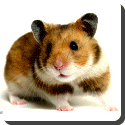 Hamster — Hamsters are rodents belonging to the subfamily Cricetinae. The subfamily contains about 18 species, classified in six or seven genera. Hamsters come in lots of different colours and shapes. Because they are easy to breed in captivity, hamsters are often used as lab animals and kept as pets in more economically developed countries. Over recent years they are very commonly used as pets for the common family.
Hamster — Hamsters are rodents belonging to the subfamily Cricetinae. The subfamily contains about 18 species, classified in six or seven genera. Hamsters come in lots of different colours and shapes. Because they are easy to breed in captivity, hamsters are often used as lab animals and kept as pets in more economically developed countries. Over recent years they are very commonly used as pets for the common family.
Hamsters are crepuscular. In the wild, they burrow underground in the daylight to avoid being caught by predators. They are most active around dusk and dawn, which has led many people to mistake them for being nocturnal. In the wild they will eat any wheat, nuts and small bits of fruit and vegetables that they might find lying around on the ground, occasionally eating small insects such as small crickets or mealworms. Hamsters got their name from the German word “Hamstern” which means to hoard. They have elogated fur lined pouches on both sides of their heads which extends to their shoulders, which they stuff full of food to be brought back to the colony or eaten later.
Their diet contains a variety of foods both In the wild and when kept as a pets including dried food, berries and nuts, hard boiled or scrambled eggs, chicken and turkey. Fresh fruits and vegetables are also an integral part of their diet.Behavior really depends on their environment, genetics, and interaction with people.
Hamsters are stout-bodied, with tails much shorter than body length and have small furry ears, short stocky legs, and wide feet. Their thick fur–which can be long or short–can be black, gray, white, brown, buff, yellow, “sapphire” and red depending on the species, or a mix of any of those colours; under parts are white to shades of gray and black. The Djhungarian hamster (Phodopus cambpelli) and the striped dwarf hamster (Cricetulus barabensis) have a dark stripe down the middle of the back. Dwarf desert hamsters (genus Phodopus) are smallest, with bodies 5 to 10 cm (about 2 to 4 inches) long; the largest is the Common hamster (Cricetus cricetus), measuring up to 34 cm long, not including a short tail of up to 6 cm. Usually it’s not that long, and on a long haired hamster it’s barely visible.
Hamsters are omnivorous. Their diet consists mostly of grains (such as corns) but also includes fresh fruit, roots (such as carrots), green parts of plants, invertebrates, and other small animals. Hamsters carry food in their spacious cheek pouches to cache in the burrow. Hamsters in the Middle East have been known to hunt in packs to find fish for food.
Pet stores sell a large variety of treats that are suitable for hamsters. It’s important not to give the hamster too many of these, especially ones that are high in fat or sugar, because they could lead to a hamster getting fat. Healthy alternatives include acorns and yogurt.
Most people can feed their hamster a lot of things from everyday food in their kitchen. Although the previously mentioned items are safe for hamsters to eat, not every hamster will enjoy the taste of all of those foods. It is also important to thoroughly wash fruits, vegetables and greens before feeding, as they can have traces of pesticides. Some foods to avoid giving hamsters are kidney beans, onion, garlic, large ammounts of citrus fruit, and potato sprouts.
Syrian hamsters are generally solitary, where as Dwarf hamsters can get along with others of the same species. They are primarily consdered crepuscular and were at one point were considered nocturnal as they are sometimes active all night. They are excellent diggers, constructing burrows with one or more entrances and with galleries that are connected to chambers for nesting, food storage, and other activities. They also like appropriate tunnels made by other mammals; the striped hairy-footed hamster (Phodopus sungorus), for instance, uses paths and burrows of the pika. None hibernate during winter, but some experience periods of torpor lasting from a few days to several weeks. Hamsters are known to stockpile large amounts of food. Hamsters dislike swimming but if forced to will inflate their cheek pouches with air to help them float.
 Kids Portal For Parents India Kids Network
Kids Portal For Parents India Kids Network






